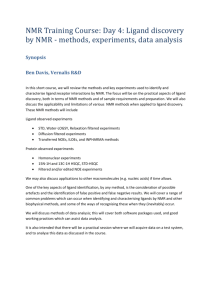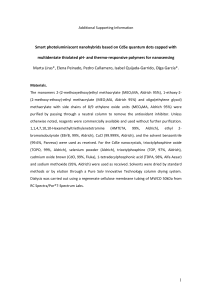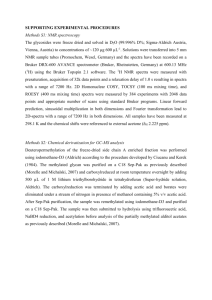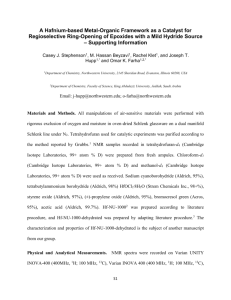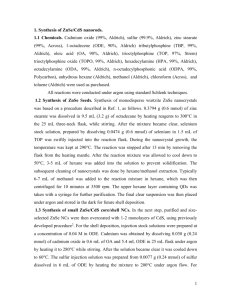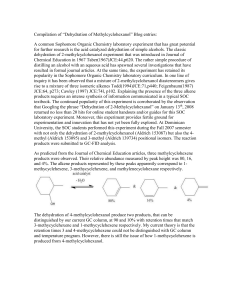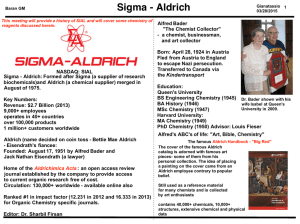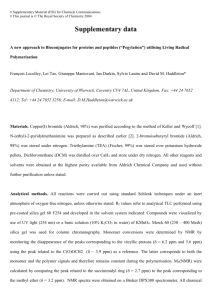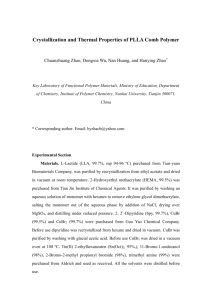pola27671-sup-0001-suppinfo01
advertisement
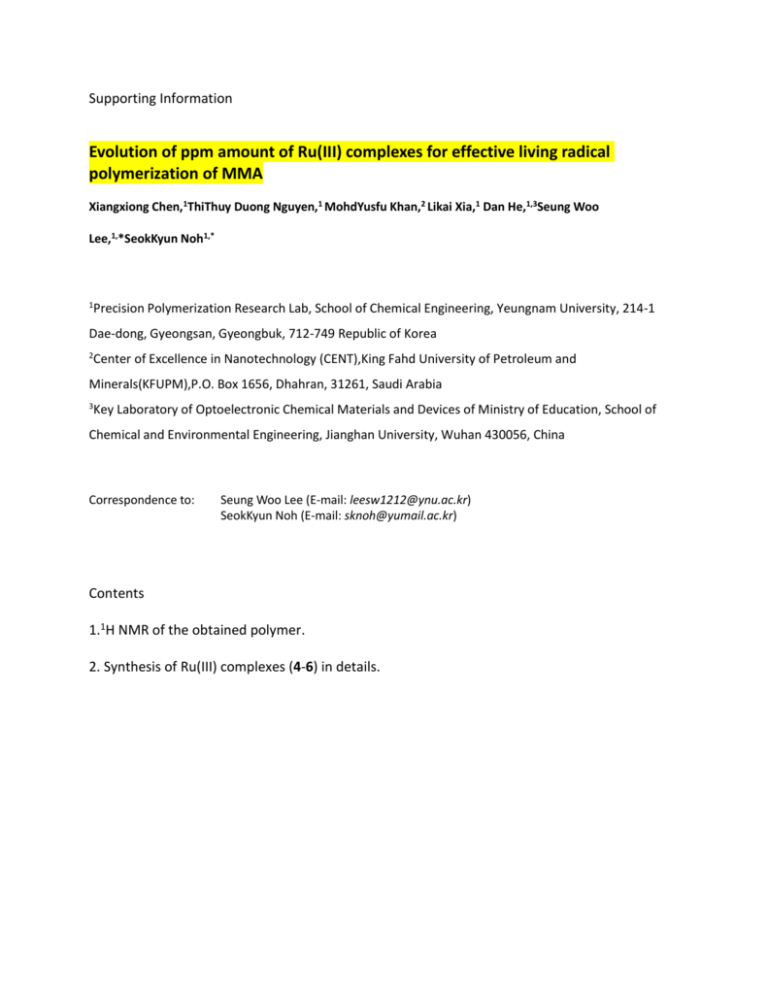
Supporting Information Evolution of ppm amount of Ru(III) complexes for effective living radical polymerization of MMA Xiangxiong Chen,1ThiThuy Duong Nguyen,1 MohdYusfu Khan,2 Likai Xia,1 Dan He,1,3Seung Woo Lee,1,*SeokKyun Noh1,* 1 Precision Polymerization Research Lab, School of Chemical Engineering, Yeungnam University, 214-1 Dae-dong, Gyeongsan, Gyeongbuk, 712-749 Republic of Korea 2 Center of Excellence in Nanotechnology (CENT),King Fahd University of Petroleum and Minerals(KFUPM),P.O. Box 1656, Dhahran, 31261, Saudi Arabia 3 Key Laboratory of Optoelectronic Chemical Materials and Devices of Ministry of Education, School of Chemical and Environmental Engineering, Jianghan University, Wuhan 430056, China Correspondence to: Seung Woo Lee (E-mail: leesw1212@ynu.ac.kr) SeokKyun Noh (E-mail: sknoh@yumail.ac.kr) Contents 1.1H NMR of the obtained polymer. 2. Synthesis of Ru(III) complexes (4-6) in details. 1. 1H NMR of the obtained polymer. FIGURE S11H NMR of the obtained polymer. Polymerization mechanism was firstly studied by 1H NMR of the obtained polymer. The broad signals at 3.8–4.0 ppm were observed, which should be the chemical shift for the methine proton at the chain end of PMMA-Br. 2. Synthesis of Ru(III) complexes (4-6) Materials Methyl methacrylate (MMA) (Aldrich, 99%) was passed through a column filled with neutral alumina to remove the inhibitor, dried over CaH2 to remove moisture, distilled under reduced pressure, and stored in a freezer under nitrogen. Tetrahydrofuran (THF) (Fisher, HPLC grade) was freshly distilled from Na/K alloy with benzophenone (Aldrich, 99%) and stored under nitrogen. Diphenyl-(2-methoxyphenyl) phosphine (ligand (1)) (Aldrich, 98%), triphenylphosphine(ligand (2)) (Aldrich, 99%),2-(diphenylphosphino) pyridine (ligand (3)) (Aldrich, 97%),pentamethylcyclopentadienyl ruthenium (III) chloride polymer ((Cp*RuCl2)n) (Aldrich, 98%),ethyl-2-bromoisobutyrate (EBriB) (Aldrich, 98%), aluminum isopropoxide (Al(Oi-Pr)3) (Aldrich, 98%), anisole (Aldrich, 99%), methyl ethyl ketone (MEK) (Aldrich, 99+%),and all other solvents were used as received.MMA and solvents were purged by bubbling with dry nitrogen for 30 min to remove the dissolved oxygen before polymerization. All the glassware, needles and stirring bars were dried overnight in an oven at 110°C and purged with nitrogen to remove oxygen. Preparation of complex (4) Complex (4) was synthesized using the following process: [Cp*(RuCl2)]n (320mg, 1.04/n mmol) and ligand (1) (340mg, 1.16 mmol) were added to a 250mL flask with a stirring bar. The flask was evacuated for 10 minutes to remove oxygen. Subsequently, 15ml distilled ethanol was added to the flask through a degassed syringe. The initial black mixture turned orange – brown and finally orange after 15 hours of stirring. 30mL diethyl ether was then slowly added to the flask through a degassed syringe to precipitate the ruthenium (III) complex. After reducing the volume of the washing solution (containing ethanol and diethyl ether), the precipitate was washed in diethyl ether 2 or 3 times to remove the unreacted ligand. The precipitate was filtered and vacuumed overnight. An orange solid was obtained.Yield: 560 mg (0.93 mmol, 85%). m.p. 245°C, EA: C29H32PORuCl2 (599.3): Calc. C 58.1, H 5.3; Found C 57.9, H 5.4. 31P NMR (CDCl3, 600MHz): (ppm) = 24.8. Complex (5) It was synthesized according to a previous report.S1 Preparation of complex (6) Complex (6) was synthesized from 320 mg [Cp*(RuCl2)]n and 305 mg ligand (3) using a similar procedure to that used in the above process. Yield: 488mg (0.85 mmol, 78%). M.p. 260 oC, EA: C27H29NPRuCl2 (570.3): Calc. C 56.8, H 5.1, N 2.4; Found C 56.5, H 5.1, N 2.5, 31P NMR (CDCl3, 600MHz); (ppm) = 21.3. REFERENCES S1. W. A. Braunecker, K. Matyjaszewski, Prog. Polym. Sci. 2007, 32, 93-146.
